German Renault R35 Replica Tank
There is a replica of a captured French Renault R35 tank (Panzerkampfwagen 731 R(f)) that saw action in the German Army in Normandy, France in 1944 against American Paratroopers. It is in the US Airborne Museum in Saint-Mere-Eglise. It took part in the battle of La Fiere 9th June 1945 along with another Renault R35 tank and another captured French tank a Hotchkiss H39.
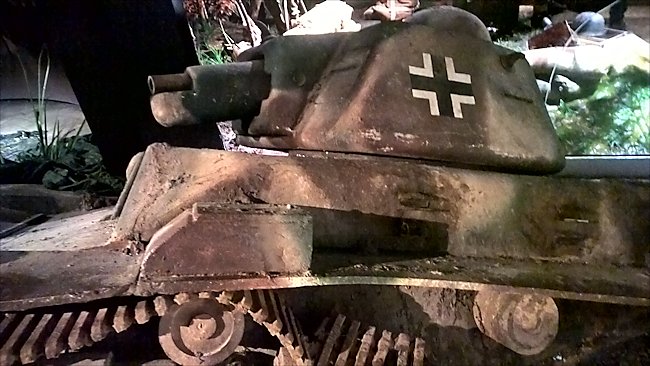
German Renault R35 Replica Tank at the Airborne Museum in Saint-Mere-Eglise, Normandy, France.
Location
Head towards Saint-Mere-Eglise. Either use the town center setting on your Sat-Nav or type in Rue Eisenhower, Saint-Mere-Eglise. Both will get you to the large car park outside the museum opposite the town church. Look out for the paratrooper hanging from the church roof by his parachute in memory of US Paratrooper John Steel.
Specification
The captured French Renault R35 tank was obsolete in 1944 when the Allies landed on the Normandy beaches. It was only armed with a 37mm L/21 SA18 gun. It had one 7.5 mm MAC31 Reibel machine gun next to the main gun in the turret. There was no hull machine gun. It had a maximum armour thickness of 43mm.
The Renault R35 was powered by a Renault V-4 engine that produced only 84 hp. It was very slow an only had a maximum road speed of only 20 km/h (12.42 mph). It only had a crew of two: commander/gunner and driver. They were built between 1936 and 1940. Around 1,540 were built. After 1940 captured Renault R35 tanks that were servisable were used by the German army for costal defence and internal security. They were called Panzerkampfwagen 35R 731 (f). Some were sent to tank driver training units.
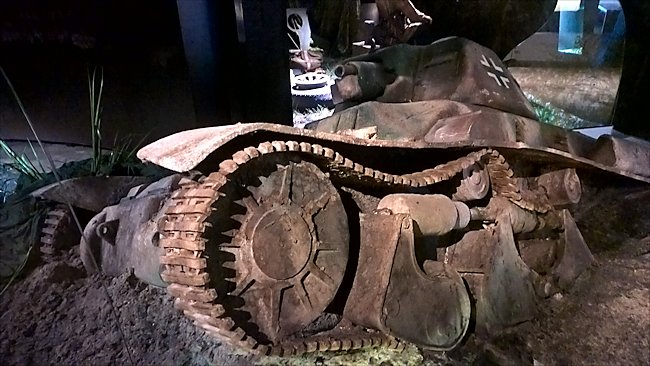
Captured French Renault R35 Replica Tanks was called the Panzerkampfwagen 35R 731 (f) by the German Army
Deployment in Normandy 1944
Fourteen captured French Army Renault R35 tanks, used to train tank drivers, equipped the German Army 100th Panzer-Ersatz-Bataillon (100th Panzer Replacement Battalion) in the German Seventh Army in 1944. On 6 June 1944, they were among the first Armee-Reserve units sent into combat near Sainte-Mère-Église to oppose the American airborne landings in Normandy. Supporting a counterattack by the 1057th Grenadier Regiment, R35s penetrated the command post of the U.S. 1st Battalion 505th Parachute Infantry Regiment before being destroyed by bazooka fire.
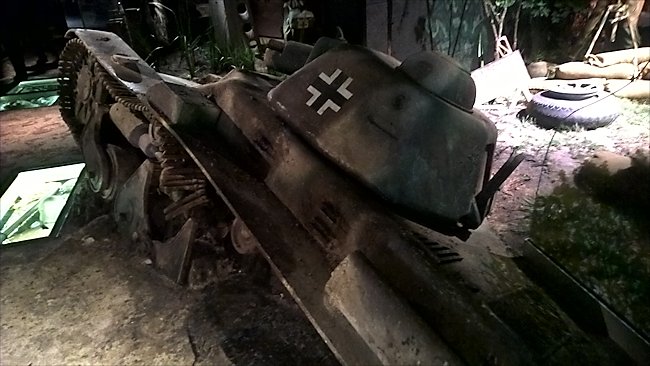
German Renault R35 Replica Tank slipping into the flooded fields at the side of the road diorama.
The River Merderet La Fiere Battle 9th June 1944 Cauquigny
In the US Airborne Forces Museum in Saint-Mere-Eglise a few miles inland from Utah Beach, there is a fiberglass replica of a knocked out captured French Renault R35 tank that had been used by the German Army. It is exhibited as half sunk in a swamp and illustrates the fierce German counter attack the US paratroopers had to fight off on D-day that will come to be known as the battle of La Fiere.
Unfortunately none of the knocked out three French tanks survived the hands of the post war scrap-metal merchants. This battle is unusual in that it featured captured French Army tanks last used by the French in 1940. Most of these tank chassis were turned into self-propelled anti-tank and artillery guns like the German Marder series of SPG's .
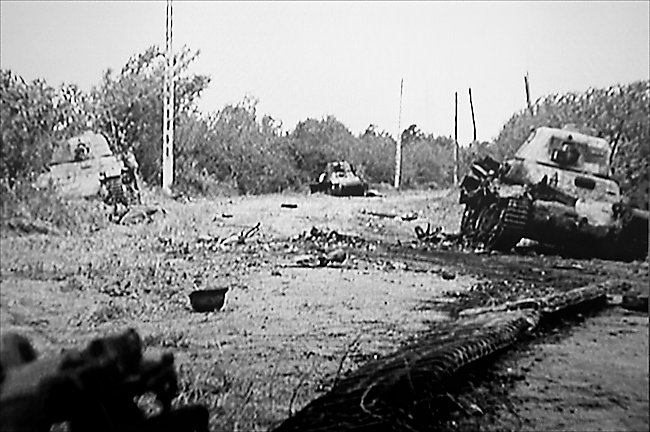
The Germans used two captured French Army Renault R35 tanks (the one in the centre and the one on the right) and one Hotchkiss H39 tank (the one on the left) to attack the American paratroopers at La Fiere near Sainte Mere Eglise. They were knocked out by bazookas and a 57mm anti-tank gun.

German Renault R35 Replica Tank sunk in the swamp
Those that were kept as tanks were used by the Germans in a 'policing' roll rather than a front line tank. In 1944 these tanks were considered obsolete.
On D-Day, 6th June 1944, in the early hours, 'A' Company of the 505th PIR commanded by Lt. Dolan, along with some displaced men from the 507th and 508th regiments, attack and capture the La Fiere bridge and nearby stone manor house
Later that day German infantry and tanks return to attack the bridge. An American 57mm gun, which had arrived by glider, had be set up on higher ground above the manor house. It is spotted and a high explosive HE round from one of the German tanks puts it out of action.
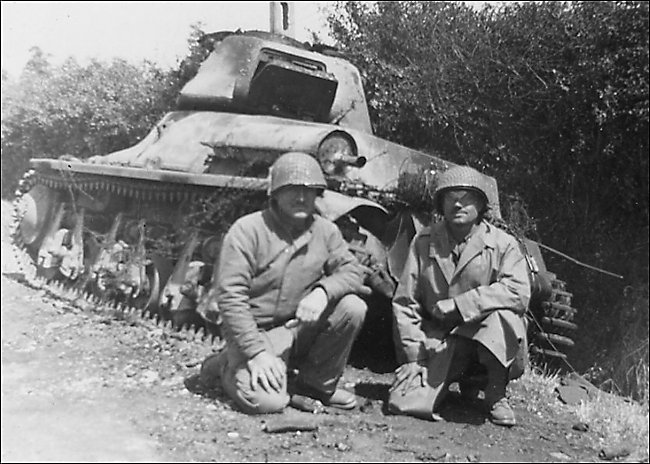
Knocked out German Renault R35 Tank
Four US paratroopers armed with two bazookas, positioned near the to the bridge manage to knock out the German tanks. The road to La Fiere now bears the name of one of these men - Marcus Heim. During the battle, US Major Kellam, the commanding officer of the 1st Battalion 505th Parachute Infantry Regiment (PIR) is Killed.
On the 7th June 1944, following a sustained artillery bombardment the Germans launch another counter attack. The 505th PIR suffer heavy losses but stand their ground, despite overwhelming odds and a severe lack of equipment and ammunition.
On the 8th June 1944 the group of paratroopers defending the bridge receives reinforcements from the 507th PIR commanded by Captain Rae. Of the 147 men originally assembled by Lt. Dolan only 81 are still alive. The Germans continue to counter attack on both sides of the Merderet River.
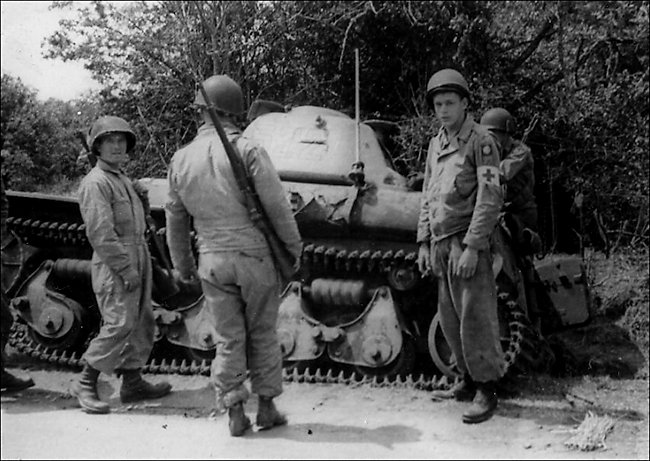
Knocked out German Renault R35 Tank
On the 9th June 1944 in order to secure control of the crossing General Gavin launches an all out assault over the flooded marshes. The casualties on both sides are horrific, but the men of the 507th PIR and 325th Glider Infantry Regiment supported by tanks brought in from Utah Beach succeed in occupying once and for all, the village of Cauquigny on the other side.
The battle at la Fiere lasted for 3 days and has become legendary due to the ferocity of the combat and the huge losses incurred in men and equipment on both sides..
D-Day 1944 books

